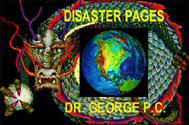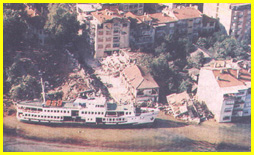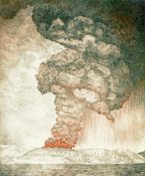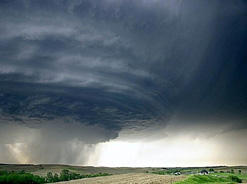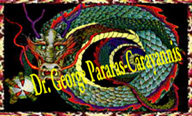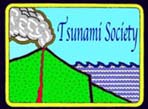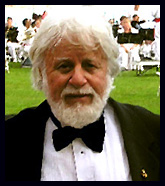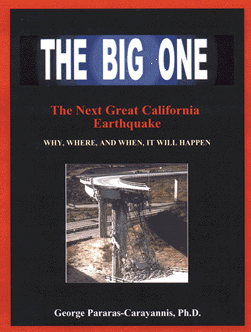EARLY TSUNAMI RESEARCH IN THE U.S. - A Brief History
George Pararas-Carayannis

Tsunami
Research in the U. S. began at the University of Hawaii after
the April 1, 1946 tsunami struck the Hawaiian Islands and caused
many deaths and extensive destruction. Francis Shepard from
the Scripps Institution of Oceanography, Gordon Mcdonald
and Doak Cox from the University of Hawaii participated in
the initial survey and
wrote
an extensive
report on the tsunami and its impact.
Additional Pacific-wide tsunamis that struck the Hawaiian
Islands in 1952, 1957 and 1960, were investigated by the U.S.
Army
Corps of Engineers, the U.S. Coast and Geodetic Survey and
University of Hawaii scientists, who documented wave
height
distribution and impact, mainly in the Hawaiian
Islands.
Following the devastating May 22, 1960 tsunami from Chile,
the State of Hawaii provided funds for a program of tsunami
investigations at the University.
Doak
Cox, then
employed
at the Sugar
Planters Research Facility transferred to the University.
He was joined by Martin Vitousek, Rockne Johnson, Gordon
Groves
and others who had participated in the International
Geophysical Year. On October 13 and 19, 1963, two Saturdays
apart, the
Honolulu Observatory (HO) of the U.S.
Coast and Geodetic Survey (USCGS),
issued tsunami warnings for earthquakes off Hokkaido,
Japan. No tsunamis of significance occurred in Hawaii
and the public
perceived that the tsunami warnings were faulty. There
was a great deal of criticism in the press about the inconvenience
and
there was growing pressure to improve the existing U.S.
Tsunami
Warning
System, administered by the Honolulu Observatory (now
known as the Pacific Tsunami Warning Center, or PTWC).
In 1964, the construction of the Hawaii Institute of
Geophysics (HIG) building was completed at the University
of Hawaii campus in Manoa Valley. Dr. George Woollard arrived
from the University of Wisconsin to assume the HIG Directorship.
He brought with him geophysicists, graduate students
and the
contracts
he had with the Office of Naval Research (ONR) to continue
his investigations of the MOHOLE project. [HIG later
evolved into HIGP,
a branch of SOEST.] "MOHOLE", and in competition with
the then Soviet Union, was the race to drill through the earth's
crust to the mantle and determine its consistency and possibly
determine the earth's and our solar system's evolution. Finding
the thinnest part of the earth's crust to drill the MOHOLE became
one of the major research projects. The Geology, Oceanography and
Geophysics Departments
came under
the
umbrella
of HIG at that
time.
The University’s
newly established Computing Center occupied a wing of
the 3rd floor. A fishing boat from Alaska, the “Neptune”,
was purchased and equipped to conduct the offshore seismic
surveys for a MOHOLE site and other oceanographic investigations.
Graduate students in
Oceanography, Geology and Geophysics begun to participate
in these surveys and study tsunamis as well.
The 1964 Aleutian Earthquake and Tsunami intensified
a program of tsunami research at HIG. Doak Cox, Ralph
Moberly, Augustine
Furumoto were given additional funds by the State of Hawaii and
by the National Academy of Engineering to investigate the 1964
tsunami.
Doak Cox hired
graduate students to assist in this effort. George
Pararas-Carayannis was one of them. He prepared wave
refraction diagrams
of the 1964 tsunami and, jointly with Gus Furumoto,
wrote an
HIG Report
about the tsunami source mechanism. This report, as well as one
prepared by Doak Cox and another by Harold Loomis were included
in
the final
volume
of the National Academy of Science on the Great Alaska
Earthquake of 1964.
In 1965, an agreement was reached between the University
of Hawaii and the U.S. Coast and Geodetic Survey (USCGS)
to form
the Joint
Tsunami Research Effort (JTRE). Additional funding
was provided by the State of Hawaii and the USCGS to continue the on-going
tsunami
research at HIG and to support the cooperative effort
by bringing in new
people. The tsunami research team at that time included
professors, researchers and graduate students who were
already working
at HIG or other University of Hawaii departments. Some
of them had
dual appointments and could only work on a part time
basis. Doak Cox, Gus Furumoto, Bill Adams, Martin Vitousek,
Rockne
Johnson,
Harold Loomis, and HIG graduate students Don Hussong,
Fred Duennebier, Floyd McCoy, Gary Stice, Frisbee Campbell,
George
Pararas-Carayannis,
Daniel Walker, Tom Sokolowski and others were already
participating actively in the tsunami research program.
Most of
the people had dual
appointments, worked part-time or were paid from other
University funding. For example Harold Loomis was with
the Mathematics
Department.
Subsequently in 1965, Gaylord Miller, Gordon Groves,
Lester Spielvogel and Jim Larsen joined the Group.
Bill Adams served
as the initial
Director of JTRE (Joint Tsunami Research Effort),
then Gaylord Miller - who had worked with Walter Munk at the
Scripps Institution of Oceanography on long period wave research.
Rudolph Preisendorfer was a visiting scientist. Doak Cox assumed
the
Directorship
of
the
Environmental
Center at the Univeristy but continued to be active with JTRE.
In 1967 George Pararas-Carayannis went to work as oceanographer/geophysicist
for the newly formed International Tsunami
Information Center (ITIC), under the auspices of the Intergovernmental
Oceanographic Commission (IOC) of UNESCO, but continued his close cooperation on JTRE Group research – working with Doak
Cox on the historical tsunami database and with
Gaylord Miller on numerical modeling and tsunami travel time
charts for the warning system. Subsequent
government reorganizations brought JTRE under the joint auspices
of the University of Hawaii
and the newly established
U.S. Environmental Services Science Administration
(ESSA) then, in the 1970’s, the Pacific Marine Environmental
Laboratory, ERL, NOAA (ESSA reorganized under this new name) provided
funding through
the
University’s
Research Corporation to support newly appointed scientists and additional
graduate students.
During the 1970s Gaylord Miller, George Curtis, Harold Loomis,
and Lester Spielvogel continued to carry out
tsunami research at the University
of Hawaii with such support. Charles
Mader was with the
Los Alamos Laboratory, but was an active participant in the U.S.
tsunami program.
There was no other significant tsunami research
being carried out anywhere in the U.S. at the time, although scientists
like George Carier at Harvard were primarily involved in theoretical
studies of wave theory.
Focus of Research
The
scope of the early research at JTRE in Hawaii - was as
diversified as the background and expertise of the scientists
in the
program.
For example, Harold Loomis published a number of papers
on the hydrodynamics of long period waves, their normal
modes of oscillation
in confined
bays and harbors, the effects of resonance on long wave amplification
and
on the spectral
analysis of tsunami records. Gaylord
Miller, an expert on long period waves, worked on a tsunami
propagation modeling program, the run-up of bores, and the
relative spectra of tsunamis
and tides. Tom Sokolowski worked on a quadripartite seismic
array to supply additional data for the Tsunami Warning System.
Gordon Groves, Bob Harvey and Eddie Bernard worked on the dissipation
of tsunamis, their spectral decomposition and the non-linear
behavior
at
islands and continental
coastlines.
Bill Adams, George Pararas-Carayannis and others, continued to
work on tsunami anomalies and precursory seismic phenomena
as predictors
of
potential
tsunami
inundation. Charles Mader refined his pioneering work on the
numerical simulation of tsunamis. Rockne Johsson worked on
acoustic waves
of submarine
volcanic
eruptions,
and earthquake locations and length of earthquake ruptures
from T-phase signatures.
Together
with Fred Duennebier they worked on T-phase sources, their
spectral variations and their use in earthquake epicenter
determinations. Gus Furumoto worked on ionospheric recordings
of Rayleigh waves and the seismicity of Hawaii. Together, with
graduate
students
Cambell
Frisbee
and Donald Hussong
they analyzed seismic refraction surveys of the Hawaiian
Ridge to determine velocity layers and the crustal stucture
of the
Hawaiian Archipelago. George Pararas-Carayannis and James Sasser used a spherical hyperbola program of time differences in the arrival of compressive seismic waves at select sismic stations, to develop charts for rapid earthquake epicenter deteminations.
Rudolph
Preisendorfer worked on classic canal theory, multimoded
long surface waves and on tsunami theory
(generation, boundary,
propagation, refraction,
diffraction, scattering, trapping and resonance problems).
Lester Spielvogel worked on asymptotic theory for waves with
radial symmetry and on the speed of solitary waves and run-up
of waves
on sloping beaches. Dan Walker worked with George Sutton
on oceanic mantle phases and the systematic analysis of compressional
and shear wave
arrivals at hydrophones
on Pacific
Island stations. Ralph Moberly and Floyd McCoy Jr.
worked on the marine geology of the sea floor of the Eastern
Hawaiian
Islands. Also, Gary Stice
and Floyd
McCoy
Jr. worked
on the
Geology of the Man’ua Islands in Samoa. Floyd
McCoy developed a keen interest in the Bronze Age eruption
of the
volcano of Santorini in Greece and wrote about
the volcano’s eruption phases and the tsunami
it generated. Martin Vitousek worked extensively on
tsunami
instrumentation and
high resolution data telemetry systems. Together with
Gaylord Miller
they
used vibrotron
instrumentation to measure tsunami and other low-frequency
waves in the deep ocean. These are only some of the
early research activities that were carried out at
JTRE in the first
decade of its establishment, and this was the extent of early
tsunami research in the U.S.
JTRE’s Contributions to the Pacific Tsunami
Warning System
In 1965, the newly established JTRE played a significant
role in many improvements of the Tsunami Warning System.
Several
of the
JTRE scientists
participated
as observers and provided input to the First Meeting of
the International Coordinating Group of the Tsunami Warning
System
in the Pacific
(ITSU) at the East West
Center
in 1968. This international meeting resulted in the formation
of the Pacific Tsunami Warning System, of ITIC International Tsunami Information
Center) and the
relocation
of the World Data Center A – Tsunami to ITIC. Gaylord Miller, George Pararas-Carayannis and JTRE scientists participated
as members of the U.S. team
in several
other ITSU meetings.
JTRE established an early experimental local Tsunami Warning
System for the Hawaiian Islands. Martin Vitousek and
Bill Adams, in cooperation
with he
Hawaii Volcano
Observatory and the Hawaii Civil Defense Agency, established
data telemetry of sea level from existing tide gauges.
They positioned two new pressure
sensors along the south and west coasts of the island
of Hawaii. A third
unit consisting
of a bottom–mounted pressure sensor and an acoustic
transponder was placed below a buoy about 100 km north
of the Hawaiian Islands. This was the predecessor
to the DART ocean buoy systems presently in use around
the world's oceans for the detection of tsunamis.
A
historical catalog of tsunami events in the Pacific was compiled by
Doak Cox and George Pararas-Carayannis in the early 60's in
close cooperation with Kumizi Iida (Nagoya University in Japan)
and
published as HIG reports. George Pararas-Carayannis compiled a historical catalog of tsunamis in the Hawaiian Islands and later - together with Doak Cox - a historical catalog of tsunamis in Alaska. The historical data was
of great help
to
the
warning
system
and to
Hawaii’s Civil Defense Agency. Based on such
data or the Hawaiian Islands, the tsunami danger zones were determined
and the first tsunami evacuation maps were prepared
and published as charts in Hawaii's telephone
books to inform the public. Also, numerically developed
charts of differences in seismic p-wave arrivals
at diferent seismic stations around the Pacific
prepared
by
George Pararas-Carayannis and James Sasser in 1965,
became a much more rapid method for locating the
epicenters of tsunamigenic earthquakes by the Honolulu
Observatory – which at that time was still
using a large globe and a tape to measure “p” and “s” signal
time differences to estimate distances and triangulate
for epicenter determinations (the large globe was subsequently donated to the Smithsosnian Institute in Washington DC)
The JTRE Group was also very active in the mid 60’s in making
a number of recommendations for improvements to what was then
called the Seismic Sea Wave Warning System, subsequently
renamed the Pacific Tsunami Warning System. Some
of these recommendations were adopted and helped improve considerably
the assessment of potential tsunamis
and the speed by which tsunami warnings were issued.
For example,
Gaylord Miller and George Pararas-Carayannis prepared the first
tsunami travel charts for many of the new stations to the Tsunami
Warning System (i.e. Acapulco, Attu, Canton, Eniwetok, Kwajalein,
Johnston, La Jolla, Marcus, Nauru, Samoa,
and Wake) thus enabling the warnings issued by PTWC
to include tsunami travel information and estimated times of
arrival (ETA’s).
George Pararas-Carayannis continued this work using spherical
earth models and subsequently prepared
additional tsunami
travel time
charts for Adak,
Crescent City, Dutch Harbor, La Punta, La
Jolla, Los Angeles, San Francisco, Seward, Sitka
and Tofino - as well as flat
earth
approximations
(with variable grid systems and deep/shallow water interphases)
for refinements of the tsunami travel times in bays and continental
shelves. Additionally,
after joining ITIC where the directorship of the World Data
Center A - Tsunami had been transferred,
George
Pararas-Carayannis
served also as Director of the World Data Center A -Tsunami and continued
to work
on the historical tsunami database, updating the
catalogs of Tsunamis for the Pacific, Alaska,
Hawaii, Samoa
and the Atlantic,
an Atlas of Tsunami Marigrams and - with support of the U.S. Nuclear Regulatory Commission - developed
annotated bibliographies and
a very extensive
tsunami library for the use of JTRE and visiting
scientists. This database was subsequently provided
to Jim Lander
and the National Geophysical Data Center (NGDS
when the World
Data Center
A -
Tsunami was transferred from Honolulu to Boulder, Colorado.
JIMAR Created
With the passing of Gaylord Miller, and the recruitment
of Charles Helsley as the second Director of
HIG, a series of
discussions
about the future
of JTRE,
took place. Since it had been years since a
Pacific-wide tsunami had occurred a proposal had been made to close JTRE
down. This coincided with a move
by NOAA
to expand
their Cooperative
Institute Program. The Boulder CI ( CIRES)
was
established in 1967. New CI's were developed
at Seattle (JISAO),
Miami
(CIMAS)
and Norman
(CIMMS).
In Hawaii
JIMAR was created and an MOU was signed in September
1977. The JTRE staff was incorporated within JIMAR
and the new
CI had
three initial
research
themes:
1. tsunamis and other long-period ocean waves,
2. equatorial oceanography (reflecting new
JIMAR Director, Dennis Moore's interests)
3. climate.
JIMAR base funds came from PMEL (tsunami)
and EPOCS (Equatorial Pacific Ocean Climate
Study). Gradually the tsunami effort in Hawaii shrank.
The NOAA support for the staff decreased and
individuals
moved to
other UH departments (e.g., Loomis),
or
away from the
UH program (Spielvogel).
By the late 1970’s, The University
tsunami program was down to George Curtis
(who later retired) and Chuck Mader. George
Pararas-Carayannis, as
Director of ITIC, continued to conduct
post tsunami surveys following destructive
tsunamis
in Indonesia, Phillippines, Peru, Colombia,
Mexico and to develop an extensive historical
tsunami data base. Subsequently,
JIMAR supported a small tsunami effort, mostly helping individuals
(Gerard
Fryer and Barbara
Keating)
and small support
for graduate students
(jointly with Sea Grant). During the
1980’s, University of Hawaii alumni Walt Dudley
joined the University of Hawaii at Hilo
and wrote an account of Tsunami Inundations on Hawaii. In 1981,
Bill Adams, Gus Furomoto and George Pararas-Carayannis founded
the Tsunami Society and begun publishing the International
Journal "SCIENCE OF TSUNAMI HAZARDS" - where most of the early
tsunami
research papers were published in the U.S. In the 1990’s
Dan Walker, Chip McCrery, Gerard Fryer and Barbara Keating
(all
in HIG),
and
Cheung,
Teng, Brandis
(Engineering)
continued the Tsunami
Research program in Hawaii, but funding was
inadequate. No major Pacific-wide tsunami had occurred and interest was dwindling.
Barbara
Keating and others at the University of Hawaii and at PTWC
subsequently served as officers in the Tsunami Society for several
years. Doug
Luther
collaborated
with Eddie Bernard and PMEL in the
study of infra-gravity waves (the other long-period ocean waves).
Subsequently Gerard Fryer and Vindell Hsu moved from the Univeristy
of Hawaii to the Pacific Tsunami Warning Center at Ewa Beach.
Much of the subsequent work formerly done via JIMAR is continuing either
at
the Pacific Disaster Center or in the Department of Engineering
(through the National
Tsunami Mitigation Project). The Tsunami
Society (originally established by George Pararas-Carayannis, Augustine Furumoto and Bill Adams) and its officers – played
key roles – in
establishing the early tsunami research
program in the U.S. and continued to publish
to this day a multidisciplinary journal on tsunami
hazards. Charles Mader served as editor of the Journal for several years and archived all earlier issues pertaining to the tsunami research in the USA and elsewhere at the Library of the US. Los Alamos National Laboratory. George Pararas-Carayannis initially served as Vice-President of the Society for several more years and succeeded Barbara Keating as President of Tsunami Society and Charles Mader as Editor of the journal 'SCIENCE OF TSUNAMI HAZARDS" - an international journal published continusouly for more that three decades.
...............
